
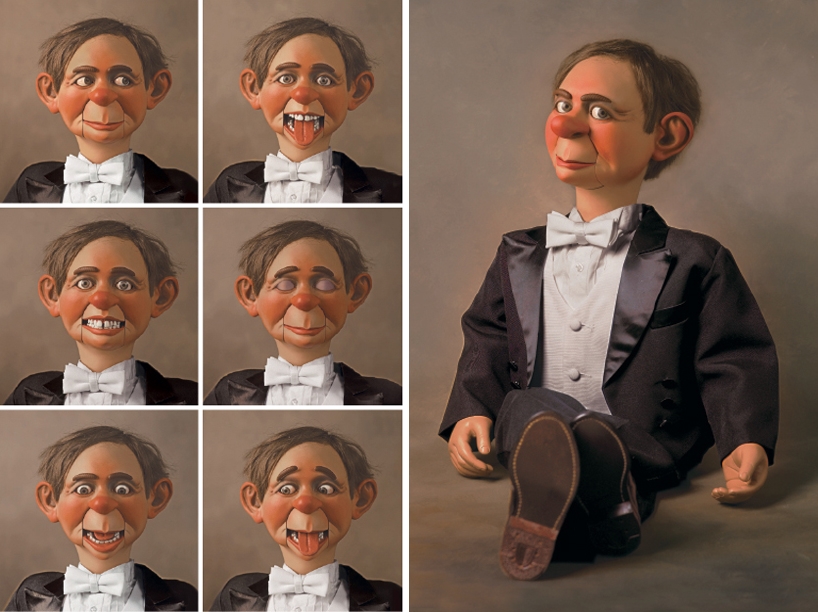



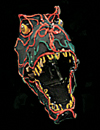
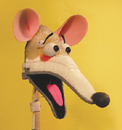
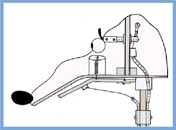
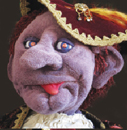
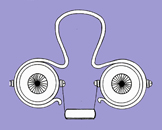
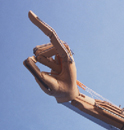
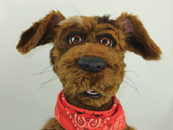

Hand and rod puppets: major categories covered in Figures in the Fourth Dimension are: hand, or "glove" puppets, hand-in-head puppets, rod puppets, "wearable" puppets or puppets worn as costumes by puppeteers, and marionettes.
As technology develops, puppetry now incorporate lighting devices. This page covers all these categories except marionettes.
Hand puppets fit over the puppeteer's hand, and are manipulated directly by the fingers.
Usually the index finger is inserted into the head, and the thumb and middle finger work the right and left arms.
Because the number of fingers in the head is so limited, the options for mechanical movement are also limited; most hand puppets have no moving facial features.
But Alice Wallace, puppetmaster for Hobgoblin Puppets, has devised an ingenious method of carving her puppets' heads to allow dramatic mouth movement.
Here are her cleverly worked out designs, different designs for human heads and for heads with a long snout, like her Alligators.
Hand-in-head puppets, like the Henson Muppets, use the fingers versus the thumb to move the mouths…a very simple and practical movement,
which allows the mouths to open at varying widths and at varying speeds, for lip synching.
But often this kind of puppet will add other features: blinking eyelids, moving eyeballs, teeth and tongue movements, even multiple ear movements.
Jim Kroupa, the expert mechanical movement builder for Henson, Disney, and many other clients, has created puppets which combine the hand-in-head feature with rod controls, and many other facial movements.
Murgatroyd, my teaching puppet, is a hand-in-head puppet, but because his face is built in a more realistic configuration, and can accommodate spaces for several fingers working at once,
the fingers of the puppeteer's hand can move, not only the mouth, but the tongue and the nose, and twist the face into many comical expressions.
Set into Murgatroyd's face is my All-Directional-Rolling-Eyeballs-With-Blinkers mechanism, an easy-to-build assembly designed for my students.
Rod puppets are often used for ventriloquist figures, constructed with an array of comical facial features.
Thurston, built by Bill Nelson and Dan Lavender, is manipulated via a "control rod" or "control stick" located inside the puppet's torso, containing triggers for each movement.
Electroluminescent wire technology is used by the innovative Corbian Arts puppet troupe, designed by Corbin Popp and Ian Carney, the principal puppeteers.
Glowing colored wires, sewn into puppet bodies which vary in size from moderate to huge, make for extremely dramatic "black theater" performances.
An additional device: a mechanical hand I built which can move very realistically. Sliders in the forearm, connected to cables in the fingers, allow each finger to move separately.
Pictures: Nelson/Lavender's Thurston funny faces. A collection of Wallace's Hobgoblin puppets, mouths open, with drawings of the mechanism.
Corbian Arts' dinosaurs….pictures of head fabrication, and a time lapse photo of a performance, and another picture of the puppeteers shown in performance and in rehearsal, where one can see the puppeteers.
Kroupa's Mouse and drawing for his mechanics. Murgatroyd with closeups of eye movements, and a diagram showing eye and eyelid movements.
Kroupa's Taxi Dog and drawing for eye movements.
For additional images showing an alternative mouth and tongue mechanism for Jim Kroupa's Taxi dog, consult the
Supplementary Materials page, Taxi Dog.